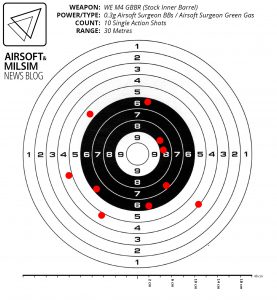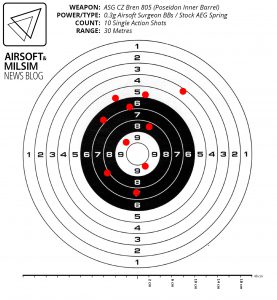Inner barrels are a dime a dozen in the Airsoft market, with most brands selling their own variety of the same style of inner barrel for multiple different replica types. It is hard to move away from what is already known to work in the Airsoft industry. Poseidon inner barrels are one of those new and innovative designs where the consumer just doesn’t know whether the new mechanic will work for them or not. Good thing our good friends and sponsors Gunfire are here with us to help by sending us samples of both Poseidon GBB and AEG inner barrels for us to test.
Poseidon’s inner barrels use a new patented design that they have called the Air Track Inner Bore design. This mechanic is supposed to stop the effect of rapid air dispersion around the ball bearing and help maintain the stability that the BB retains whilst travelling inside the inner barrel. It is said that the BB will be able to travel at a higher speed and more consistently due to allowing excess air to follow the BB’s trajectory as it travels and leaves the inner barrel without interrupting spin from the hop up unit’s action. This in theory should lead to increased range and consistency, however we are doubtful that this would maintain the same level of joule output. This is however all theoretical and as always, theory does not always translate to practice and vice versa.
 Before we start with the comparisons, we thought we’d look into what is made available from purchasing a Poseidon inner barrel. Both variants of the inner barrels come with the inner barrels and a hollow hop up nub (uncertain of degree of strength). I almost forgot to mention that they also come with a small Poseidon velcro patch in the event you find yourself in need of covering some velcro padding.
Before we start with the comparisons, we thought we’d look into what is made available from purchasing a Poseidon inner barrel. Both variants of the inner barrels come with the inner barrels and a hollow hop up nub (uncertain of degree of strength). I almost forgot to mention that they also come with a small Poseidon velcro patch in the event you find yourself in need of covering some velcro padding.
The Poseidon inner barrels are CNC machined copper manganese alloy with an electroless coating of nickel construction. This means that the barrels are strong and durable with little flex throughout their lengths and is able to maintain a smooth finish for a long period of time whilst exposed to the elements. Poseidon have also engraved their name on to the barrel for further recognition of the brand to their inner barrels themselves.
There is a difference however between the AEG and GBB inner barrels, the AEG inner barrel comes with a hop bucking which features the two prong contact points for extra contact with the BB. The GBB inner barrel unfortunately does not come with the hop bucking and we are uncertain as to why considering this would mean that the stock bucking would have to be used for the GBB tests.
For the GBB inner barrel test, we are using the WE M4 GBBR rifle which has only had external modifications applied to it where as all internals are as you’d expect when purchasing a brand new WE M4 GBBR from a store. The stock inner barrel is unfortunately longer that the provided Poseidon inner barrel, however the results will show something interesting about the difference in barrel lengths compared to the results.
 Before installing the new Poseidon inner barrel, we took the GBBR to our 30 metre range, checked the fps of the rifle, and did an accuracy test of the stock barrel to compare with the new inner barrel. Once that was done, we took the stock inner barrel out and replaced it with Poseidon’s. The installation took little effort as all we had to replace was the stock inner barrel and the hop up nub.
Before installing the new Poseidon inner barrel, we took the GBBR to our 30 metre range, checked the fps of the rifle, and did an accuracy test of the stock barrel to compare with the new inner barrel. Once that was done, we took the stock inner barrel out and replaced it with Poseidon’s. The installation took little effort as all we had to replace was the stock inner barrel and the hop up nub.
Once the installation was complete, we put the rifle back together and did the same check with the fps and the accuracy test with the same criteria and range. The stock inner barrel’s fps was rated at 370 fps with a 0.2 gram BB whilst the Poseidon inner barrel’s fps was lower at 355 fps. There was little variance in both readings for any real comparison.
The accuracy test however has shown a little improvement, however it is uncertain if the shots were more luck than a real improvement per shot of the BB’s trajectory. Because of this statement, we took to doing a range test and found that there was a more stable trajectory from the Poseidon inner barrel from 45 metres to 60 metres compared to the stock inner barrel. This is a definite improvement considering the barrel length is shorter on the Poseidon inner barrel. To summarise, the GBB barrel was slightly more stable in trajectory which lead to potentially tighter groupings and a longer range.
Leading on to the AEG inner barrel tests, we decided it was best to use ASG’s latest offering, the CZ Bren 805 A2 AEG rifle. This test would include the AEG bucking that comes with the Poseidon AEG barrel and hence will most probably see more of an improvement over the stock inner barrel’s performance. The ASG CZ Bren 805 is one very sturdy AEG with a solid performance that is on par with most modern AEGs on the market. We were fortunate to find that the Poseidon AEG inner barrel provided is the same length as the stock inner barrel provided in the CZ Bren 805.
Before installing the new Poseidon inner barrel, we took the AEG to our 30 metre range, checked the fps of the rifle, and did an accuracy test of the stock barrel to compare with the new inner barrel. Once that was done, we took the stock inner barrel out and replaced it with Poseidon’s. The installation once again took little effort even with the replacement of both the inner barrel, hop up nub and the bucking.
Once the installation was complete, we put the rifle back together and did the same check with the fps and the accuracy test with the same criteria and range. The stock inner barrel’s fps was rated at 320 fps with a 0.2 gram BB whilst the Poseidon inner barrel’s fps was slightly higher at 335 fps. We double checked to make sure as we weren’t sure if it was the compression of the bucking in the hop unit or the inner barrel itself that was causing the slight increase in the joule rating.
Once again, the accuracy test did not show any clear difference between the stock inner barrel and the Poseidon inner barrel. There seems to be some more consistency with the horizontal grouping however the vertical grouping decreased in consistency as if the bucking was increasing variance on how much spin the BB has during flight. Because we had done so with the GBB inner barrel, it was decided to perform a range test comparison between the barrels with the AEG as well. There was a considerable increase in range towards the Poseidon inner barrel as the flat trajectory of the BB was much more consistent, allowing for the CZ Bren 805 to increase its potential range from 40 metres to 60 metres much like the GBB test conducted earlier. It does seem that the new bucking needed to be worn in however as the consistency of the vertical flight of the BB was less so compared to the GBB tests.
In summary, the Poseidon inner barrels do show some improvement of flat trajectory over a longer distance. It is hard to determine whether this is due to the patented mechanic that they have set into these barrels to help with the dynamics of the air around the ball bearing. It is possible that the replicas used to test these barrels were already using quite effective inner barrels were there was little to improve. Unfortunately it is not possible to make that assumption true without further tests with other products alongside the Poseidon inner barrels. These barrels are certainly worth trying out if you have the desire to try something new with the potential for increased range and potentially some other benefits in joule power and consistency.







